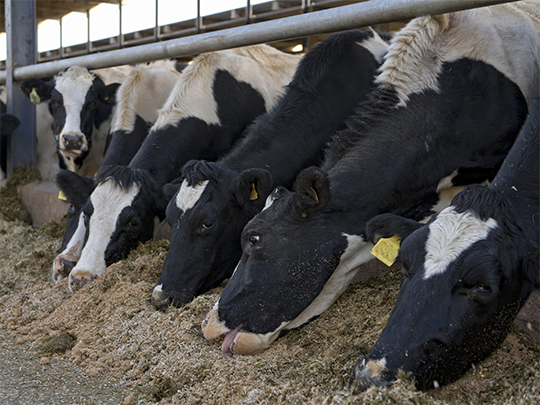Reducing emissions from ruminants (part 2)
In the first part of our blog, we discovered the rumen and read about methane production. But how to reduce methane production naturally? Learn about in part 2...
In the first part of this article you could learn all about how methane is produced in the rumen of ruminants and what makes methane so dangerous for the climate. But how can methane production be reduced – and what role can phytogenics play?
After reading this second part of the article, you will know...
- how methane production of ruminants can be reduced
- how phytogenics can contribute to mitigate methane production
What about reducing emissions from ruminants?
So far, several strategies regarding feeding, feed additives, feed conversion efficiency, microbial interventions or management practices show promising results to reduce enteric methane production from livestock.
In dairy cows, improving feed conversion efficiency (the amount of feed consumed per l of milk produced) leads to a decrease of methane output per litre of milk, because methane production decreases due to a higher milk production. Simply put, the more milk the cow produces, the less methane is emitted per litre produced (Fig. 1).
Supplementing polyunsaturated fatty acids (PUFA) and middle chain fatty acids (MCFA) describe another possibility to reduce methane production, as PUFA and MCFA have a negative effect on protozoa and methane producing archaea. However, their application is associated with a decrease in milk yield and milk fat content, as these fatty acids can become toxic to the entire ruminal flora.

Another way of reducing methane output in dairy cows is feeding diets rich in nonstructural carbohydrates and concentrates. As there is a higher amount of propionate produced when feeding high digestible carbohydrates with high amount of fermentable energy, those diets have a lower output of methane. However, they show an enhanced risk of acidosis.
Rumen microbial community composition varies with diet
Did you know that we have different methane production depending on the microbial microflora composition (methanogenic archaea, protozoa, fibrolytic bacteria, amylolytic bacteria)? Some studies have shown that the way young calves are fed can change the microflora of the rumen in the long term, with consequences for methane production.

How can phytogenics contribute to reducing emissions in ruminants?
A lot of research has been conducted on strategies to reduce methane emissions from dairy cows and beef cattle, focusing on nutritional solutions. Feed additives, including phytogenic (plant-derived) products, have been able to substantially up-value ruminant rations for years, be it for reasons of improving performance, protein efficiency or energy efficiency. But plant derived products are also on the rise when it comes to emission reduction in livestock production.

As to reduce methane emitted by dairy cows, it is necessary to reduce methanogenic archaea bacteria. Decreasing the protozoa level in the rumen leads to impaired synergies between entodiniae (protozoa) and the archea bacteria. Some plant extracts, certain essential oils and saponins, are known for their effectiveness against these bacteria and protozoa and help to control them. Moreover, the use of saponins leads to an improved propionate pathway and thus, decreasing methane production as well.
Be a Pro and use the power of plants
Figure 2 shows the results of an in vivo trial with dairy cows that were fed a phytogenic feed additive, perfectly aligned on the specific needs of ruminants, which led to a reduction of methane emitted of about 6.5% (22.2 g/l milk), compared to control animals (23.7 g/l milk). Results of this trial also proved the possibility to reduce methane production whilst at the same time increasing milk yield by about 1.8 l per day (data not shown).
Feed efficiency increased by about 5% (1.29 l/kg vs 1.26 l/kg DMI) due to the addition of the phytogenic feed additive compared to the control group. This underlines that the phytogenic feed additive improved the protein and energy efficiency of the diet whilst contributing to an obvious reduction of methane emissions.
Fig. 2 – Reduction of methane emissions in dairy cows by the use of a phytogenic feed additive, INRA 2011, in vivo trial
Challenges regarding sustainable dairy production with respect to the ever-present environmental problems, especially facing the climate change, emphasise the importance of nutritional expertise and optimum feeding management. Phytogenic feed additives have shown their ability to improve performance, support resilience of the animal and at the same time contribute to a reduction of emission losses in livestock. Hence they represent a crucial though natural tool on the frontline in the challenge of managing the balancing act of profitable and yet environmentally friendly livestock production.
Any further questions about phytogenics in ruminants?

Thierry Aubert
Thierry Aubert can look back on 15 years of experience in the premix, feed and meat industry. Since the beginning of his career, Thierry is in regular exchange with the farmers to understand their challenges and needs. In 2013 he joined Delacon as Species Leader Ruminants. With his team, he is in charge of the global product development for the ruminant species and customer technical support. Since spring 2018, his task areas have been extended: At the moment, he is also responsible for the coordination of the Reginal Technical Managers worldwide. In his leisure time, he likes to go running and already participated in several marathons.










